Business Ethics and Diversity Management at Petroleum Development Oman
VerifiedAdded on 2020/05/28
|16
|3611
|212
Report
AI Summary
This report provides an executive summary of contemporary issues for management, specifically focusing on business ethics and workplace diversity management at Petroleum Development Oman (PDO). The report examines PDO's strategies for managing business ethics, including setting ethical standards, managing stakeholder relations, and assessing ethical performance. It also discusses PDO's diversity management program, highlighting issues such as poor communication, lack of employee involvement, and underrepresentation of non-Omani employees. The report analyzes the cultural and leadership roles in maintaining business ethics, with examples from PDO's practices. It concludes with recommendations for improving diversity and ethical practices within the organization, such as formulating a more diverse management team and developing organizational policies in multiple languages. The report utilizes the provided sources to support its analysis and findings, offering a comprehensive overview of the challenges and opportunities in managing ethics and diversity in a global business context.
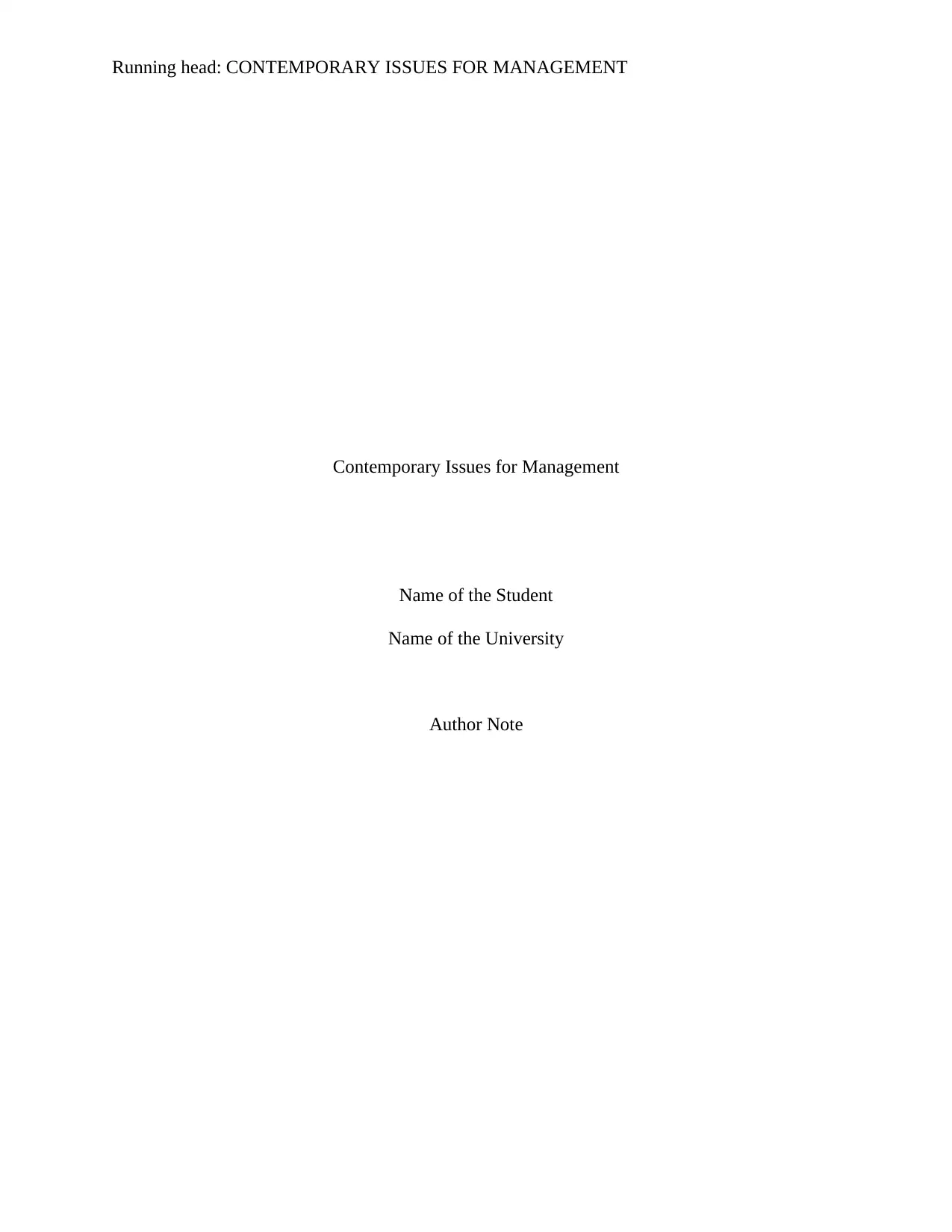
Running head: CONTEMPORARY ISSUES FOR MANAGEMENT
Contemporary Issues for Management
Name of the Student
Name of the University
Author Note
Contemporary Issues for Management
Name of the Student
Name of the University
Author Note
Paraphrase This Document
Need a fresh take? Get an instant paraphrase of this document with our AI Paraphraser
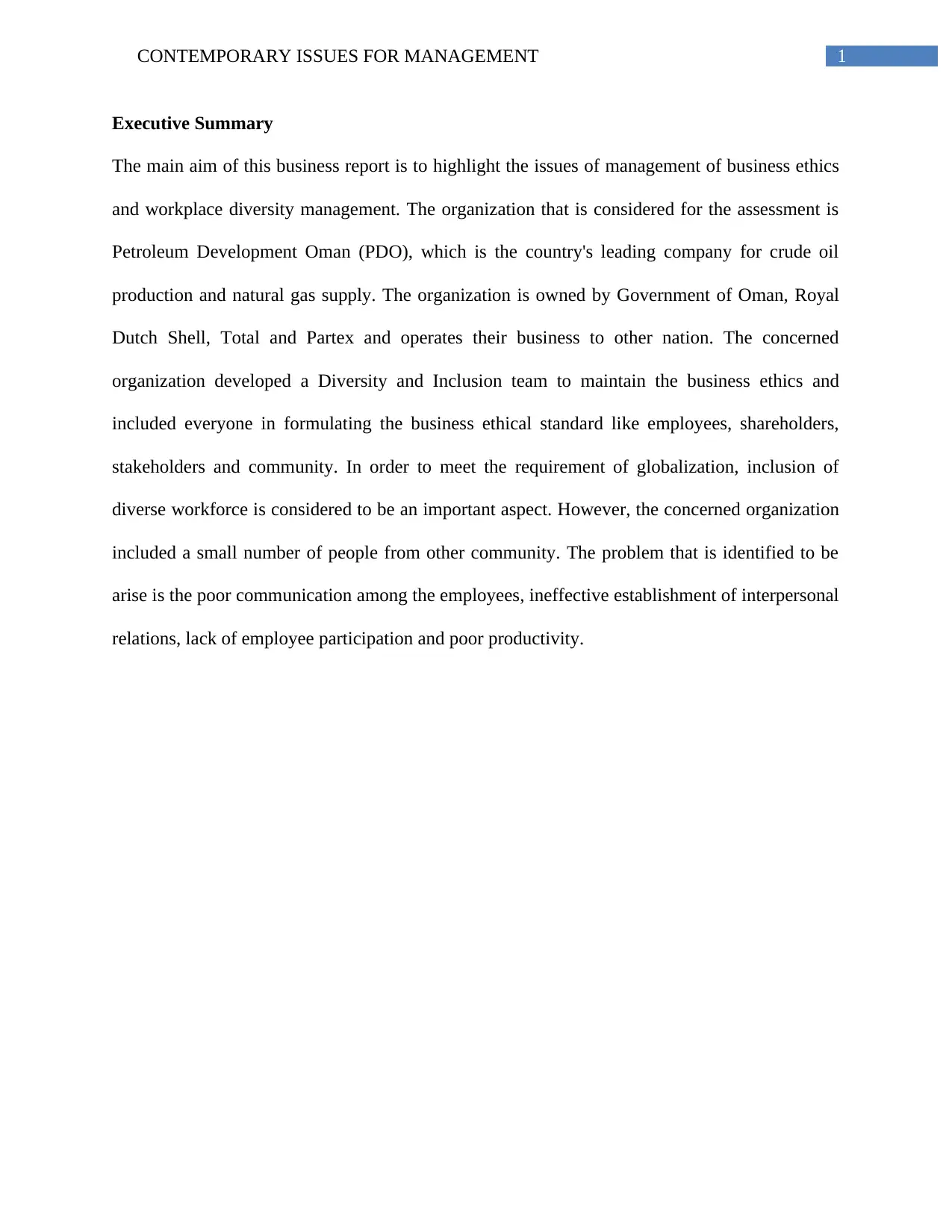
1CONTEMPORARY ISSUES FOR MANAGEMENT
Executive Summary
The main aim of this business report is to highlight the issues of management of business ethics
and workplace diversity management. The organization that is considered for the assessment is
Petroleum Development Oman (PDO), which is the country's leading company for crude oil
production and natural gas supply. The organization is owned by Government of Oman, Royal
Dutch Shell, Total and Partex and operates their business to other nation. The concerned
organization developed a Diversity and Inclusion team to maintain the business ethics and
included everyone in formulating the business ethical standard like employees, shareholders,
stakeholders and community. In order to meet the requirement of globalization, inclusion of
diverse workforce is considered to be an important aspect. However, the concerned organization
included a small number of people from other community. The problem that is identified to be
arise is the poor communication among the employees, ineffective establishment of interpersonal
relations, lack of employee participation and poor productivity.
Executive Summary
The main aim of this business report is to highlight the issues of management of business ethics
and workplace diversity management. The organization that is considered for the assessment is
Petroleum Development Oman (PDO), which is the country's leading company for crude oil
production and natural gas supply. The organization is owned by Government of Oman, Royal
Dutch Shell, Total and Partex and operates their business to other nation. The concerned
organization developed a Diversity and Inclusion team to maintain the business ethics and
included everyone in formulating the business ethical standard like employees, shareholders,
stakeholders and community. In order to meet the requirement of globalization, inclusion of
diverse workforce is considered to be an important aspect. However, the concerned organization
included a small number of people from other community. The problem that is identified to be
arise is the poor communication among the employees, ineffective establishment of interpersonal
relations, lack of employee participation and poor productivity.
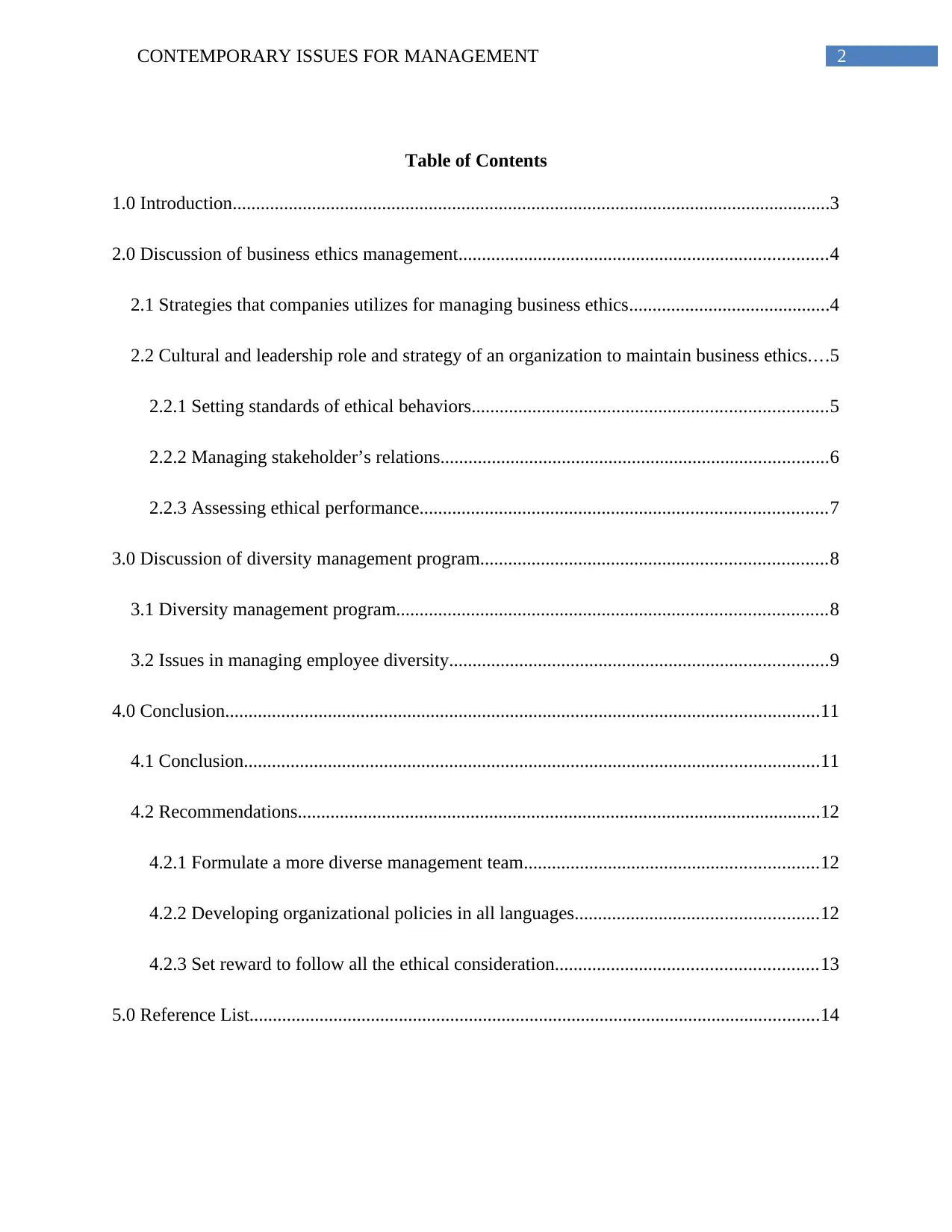
2CONTEMPORARY ISSUES FOR MANAGEMENT
Table of Contents
1.0 Introduction................................................................................................................................3
2.0 Discussion of business ethics management...............................................................................4
2.1 Strategies that companies utilizes for managing business ethics...........................................4
2.2 Cultural and leadership role and strategy of an organization to maintain business ethics....5
2.2.1 Setting standards of ethical behaviors............................................................................5
2.2.2 Managing stakeholder’s relations...................................................................................6
2.2.3 Assessing ethical performance.......................................................................................7
3.0 Discussion of diversity management program..........................................................................8
3.1 Diversity management program............................................................................................8
3.2 Issues in managing employee diversity.................................................................................9
4.0 Conclusion...............................................................................................................................11
4.1 Conclusion...........................................................................................................................11
4.2 Recommendations................................................................................................................12
4.2.1 Formulate a more diverse management team...............................................................12
4.2.2 Developing organizational policies in all languages....................................................12
4.2.3 Set reward to follow all the ethical consideration........................................................13
5.0 Reference List..........................................................................................................................14
Table of Contents
1.0 Introduction................................................................................................................................3
2.0 Discussion of business ethics management...............................................................................4
2.1 Strategies that companies utilizes for managing business ethics...........................................4
2.2 Cultural and leadership role and strategy of an organization to maintain business ethics....5
2.2.1 Setting standards of ethical behaviors............................................................................5
2.2.2 Managing stakeholder’s relations...................................................................................6
2.2.3 Assessing ethical performance.......................................................................................7
3.0 Discussion of diversity management program..........................................................................8
3.1 Diversity management program............................................................................................8
3.2 Issues in managing employee diversity.................................................................................9
4.0 Conclusion...............................................................................................................................11
4.1 Conclusion...........................................................................................................................11
4.2 Recommendations................................................................................................................12
4.2.1 Formulate a more diverse management team...............................................................12
4.2.2 Developing organizational policies in all languages....................................................12
4.2.3 Set reward to follow all the ethical consideration........................................................13
5.0 Reference List..........................................................................................................................14
⊘ This is a preview!⊘
Do you want full access?
Subscribe today to unlock all pages.

Trusted by 1+ million students worldwide
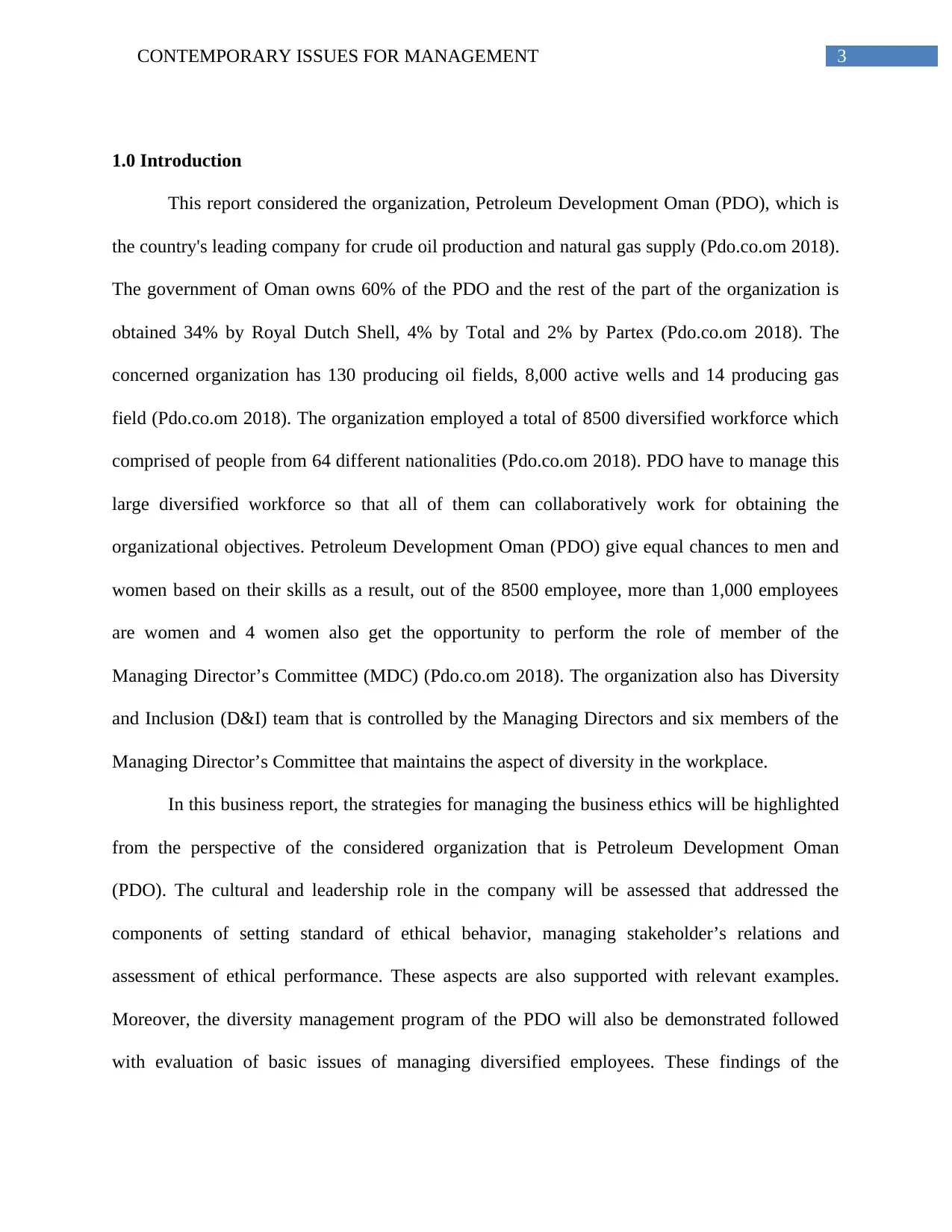
3CONTEMPORARY ISSUES FOR MANAGEMENT
1.0 Introduction
This report considered the organization, Petroleum Development Oman (PDO), which is
the country's leading company for crude oil production and natural gas supply (Pdo.co.om 2018).
The government of Oman owns 60% of the PDO and the rest of the part of the organization is
obtained 34% by Royal Dutch Shell, 4% by Total and 2% by Partex (Pdo.co.om 2018). The
concerned organization has 130 producing oil fields, 8,000 active wells and 14 producing gas
field (Pdo.co.om 2018). The organization employed a total of 8500 diversified workforce which
comprised of people from 64 different nationalities (Pdo.co.om 2018). PDO have to manage this
large diversified workforce so that all of them can collaboratively work for obtaining the
organizational objectives. Petroleum Development Oman (PDO) give equal chances to men and
women based on their skills as a result, out of the 8500 employee, more than 1,000 employees
are women and 4 women also get the opportunity to perform the role of member of the
Managing Director’s Committee (MDC) (Pdo.co.om 2018). The organization also has Diversity
and Inclusion (D&I) team that is controlled by the Managing Directors and six members of the
Managing Director’s Committee that maintains the aspect of diversity in the workplace.
In this business report, the strategies for managing the business ethics will be highlighted
from the perspective of the considered organization that is Petroleum Development Oman
(PDO). The cultural and leadership role in the company will be assessed that addressed the
components of setting standard of ethical behavior, managing stakeholder’s relations and
assessment of ethical performance. These aspects are also supported with relevant examples.
Moreover, the diversity management program of the PDO will also be demonstrated followed
with evaluation of basic issues of managing diversified employees. These findings of the
1.0 Introduction
This report considered the organization, Petroleum Development Oman (PDO), which is
the country's leading company for crude oil production and natural gas supply (Pdo.co.om 2018).
The government of Oman owns 60% of the PDO and the rest of the part of the organization is
obtained 34% by Royal Dutch Shell, 4% by Total and 2% by Partex (Pdo.co.om 2018). The
concerned organization has 130 producing oil fields, 8,000 active wells and 14 producing gas
field (Pdo.co.om 2018). The organization employed a total of 8500 diversified workforce which
comprised of people from 64 different nationalities (Pdo.co.om 2018). PDO have to manage this
large diversified workforce so that all of them can collaboratively work for obtaining the
organizational objectives. Petroleum Development Oman (PDO) give equal chances to men and
women based on their skills as a result, out of the 8500 employee, more than 1,000 employees
are women and 4 women also get the opportunity to perform the role of member of the
Managing Director’s Committee (MDC) (Pdo.co.om 2018). The organization also has Diversity
and Inclusion (D&I) team that is controlled by the Managing Directors and six members of the
Managing Director’s Committee that maintains the aspect of diversity in the workplace.
In this business report, the strategies for managing the business ethics will be highlighted
from the perspective of the considered organization that is Petroleum Development Oman
(PDO). The cultural and leadership role in the company will be assessed that addressed the
components of setting standard of ethical behavior, managing stakeholder’s relations and
assessment of ethical performance. These aspects are also supported with relevant examples.
Moreover, the diversity management program of the PDO will also be demonstrated followed
with evaluation of basic issues of managing diversified employees. These findings of the
Paraphrase This Document
Need a fresh take? Get an instant paraphrase of this document with our AI Paraphraser
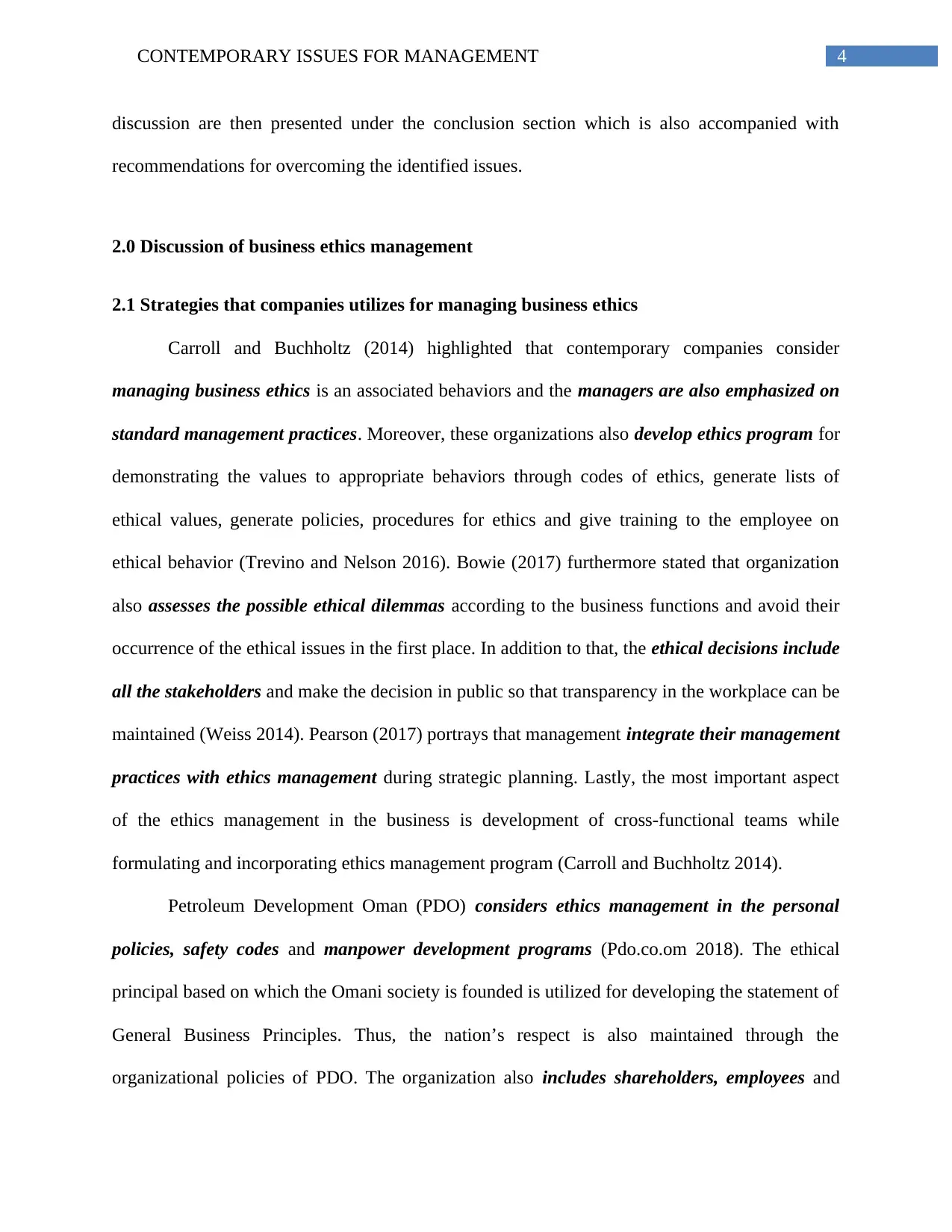
4CONTEMPORARY ISSUES FOR MANAGEMENT
discussion are then presented under the conclusion section which is also accompanied with
recommendations for overcoming the identified issues.
2.0 Discussion of business ethics management
2.1 Strategies that companies utilizes for managing business ethics
Carroll and Buchholtz (2014) highlighted that contemporary companies consider
managing business ethics is an associated behaviors and the managers are also emphasized on
standard management practices. Moreover, these organizations also develop ethics program for
demonstrating the values to appropriate behaviors through codes of ethics, generate lists of
ethical values, generate policies, procedures for ethics and give training to the employee on
ethical behavior (Trevino and Nelson 2016). Bowie (2017) furthermore stated that organization
also assesses the possible ethical dilemmas according to the business functions and avoid their
occurrence of the ethical issues in the first place. In addition to that, the ethical decisions include
all the stakeholders and make the decision in public so that transparency in the workplace can be
maintained (Weiss 2014). Pearson (2017) portrays that management integrate their management
practices with ethics management during strategic planning. Lastly, the most important aspect
of the ethics management in the business is development of cross-functional teams while
formulating and incorporating ethics management program (Carroll and Buchholtz 2014).
Petroleum Development Oman (PDO) considers ethics management in the personal
policies, safety codes and manpower development programs (Pdo.co.om 2018). The ethical
principal based on which the Omani society is founded is utilized for developing the statement of
General Business Principles. Thus, the nation’s respect is also maintained through the
organizational policies of PDO. The organization also includes shareholders, employees and
discussion are then presented under the conclusion section which is also accompanied with
recommendations for overcoming the identified issues.
2.0 Discussion of business ethics management
2.1 Strategies that companies utilizes for managing business ethics
Carroll and Buchholtz (2014) highlighted that contemporary companies consider
managing business ethics is an associated behaviors and the managers are also emphasized on
standard management practices. Moreover, these organizations also develop ethics program for
demonstrating the values to appropriate behaviors through codes of ethics, generate lists of
ethical values, generate policies, procedures for ethics and give training to the employee on
ethical behavior (Trevino and Nelson 2016). Bowie (2017) furthermore stated that organization
also assesses the possible ethical dilemmas according to the business functions and avoid their
occurrence of the ethical issues in the first place. In addition to that, the ethical decisions include
all the stakeholders and make the decision in public so that transparency in the workplace can be
maintained (Weiss 2014). Pearson (2017) portrays that management integrate their management
practices with ethics management during strategic planning. Lastly, the most important aspect
of the ethics management in the business is development of cross-functional teams while
formulating and incorporating ethics management program (Carroll and Buchholtz 2014).
Petroleum Development Oman (PDO) considers ethics management in the personal
policies, safety codes and manpower development programs (Pdo.co.om 2018). The ethical
principal based on which the Omani society is founded is utilized for developing the statement of
General Business Principles. Thus, the nation’s respect is also maintained through the
organizational policies of PDO. The organization also includes shareholders, employees and
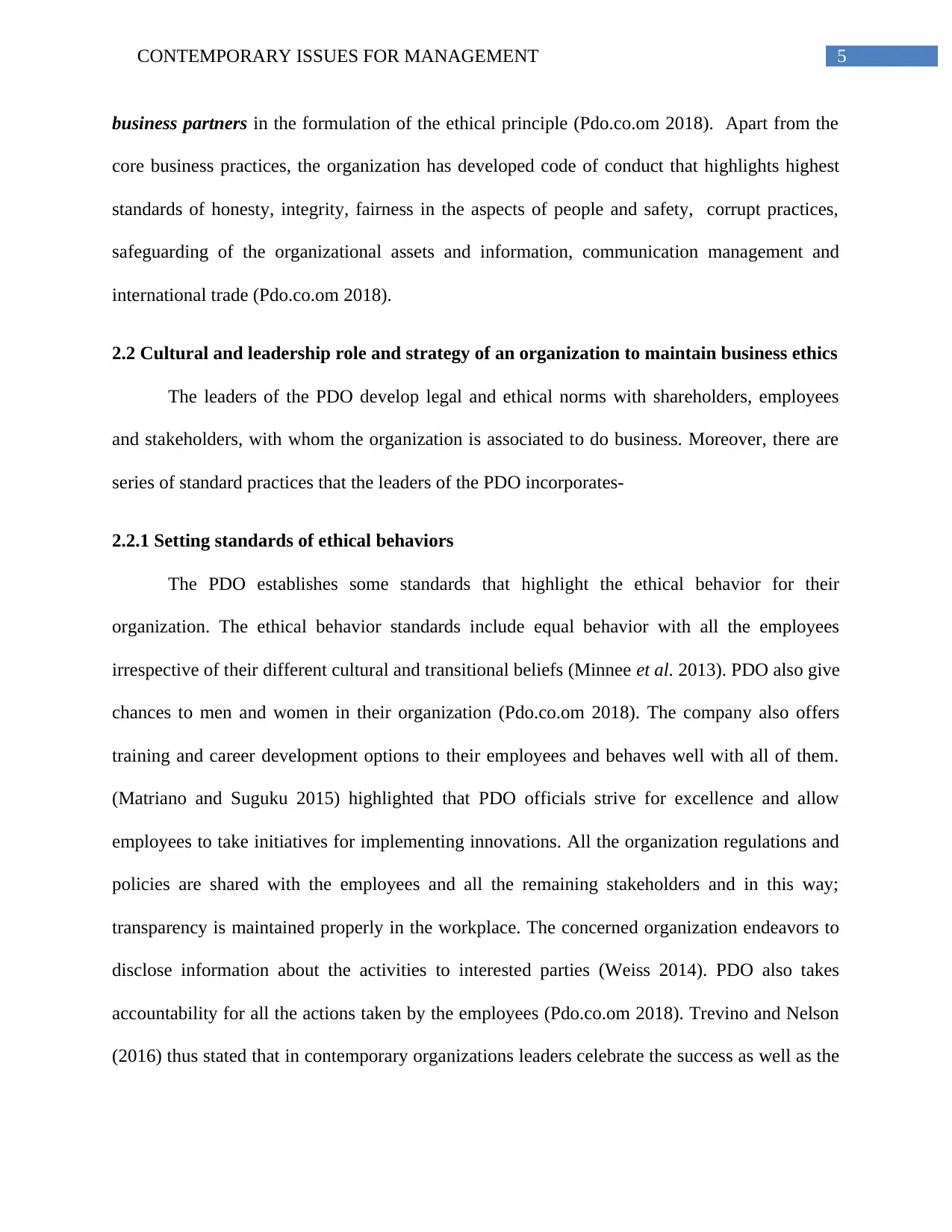
5CONTEMPORARY ISSUES FOR MANAGEMENT
business partners in the formulation of the ethical principle (Pdo.co.om 2018). Apart from the
core business practices, the organization has developed code of conduct that highlights highest
standards of honesty, integrity, fairness in the aspects of people and safety, corrupt practices,
safeguarding of the organizational assets and information, communication management and
international trade (Pdo.co.om 2018).
2.2 Cultural and leadership role and strategy of an organization to maintain business ethics
The leaders of the PDO develop legal and ethical norms with shareholders, employees
and stakeholders, with whom the organization is associated to do business. Moreover, there are
series of standard practices that the leaders of the PDO incorporates-
2.2.1 Setting standards of ethical behaviors
The PDO establishes some standards that highlight the ethical behavior for their
organization. The ethical behavior standards include equal behavior with all the employees
irrespective of their different cultural and transitional beliefs (Minnee et al. 2013). PDO also give
chances to men and women in their organization (Pdo.co.om 2018). The company also offers
training and career development options to their employees and behaves well with all of them.
(Matriano and Suguku 2015) highlighted that PDO officials strive for excellence and allow
employees to take initiatives for implementing innovations. All the organization regulations and
policies are shared with the employees and all the remaining stakeholders and in this way;
transparency is maintained properly in the workplace. The concerned organization endeavors to
disclose information about the activities to interested parties (Weiss 2014). PDO also takes
accountability for all the actions taken by the employees (Pdo.co.om 2018). Trevino and Nelson
(2016) thus stated that in contemporary organizations leaders celebrate the success as well as the
business partners in the formulation of the ethical principle (Pdo.co.om 2018). Apart from the
core business practices, the organization has developed code of conduct that highlights highest
standards of honesty, integrity, fairness in the aspects of people and safety, corrupt practices,
safeguarding of the organizational assets and information, communication management and
international trade (Pdo.co.om 2018).
2.2 Cultural and leadership role and strategy of an organization to maintain business ethics
The leaders of the PDO develop legal and ethical norms with shareholders, employees
and stakeholders, with whom the organization is associated to do business. Moreover, there are
series of standard practices that the leaders of the PDO incorporates-
2.2.1 Setting standards of ethical behaviors
The PDO establishes some standards that highlight the ethical behavior for their
organization. The ethical behavior standards include equal behavior with all the employees
irrespective of their different cultural and transitional beliefs (Minnee et al. 2013). PDO also give
chances to men and women in their organization (Pdo.co.om 2018). The company also offers
training and career development options to their employees and behaves well with all of them.
(Matriano and Suguku 2015) highlighted that PDO officials strive for excellence and allow
employees to take initiatives for implementing innovations. All the organization regulations and
policies are shared with the employees and all the remaining stakeholders and in this way;
transparency is maintained properly in the workplace. The concerned organization endeavors to
disclose information about the activities to interested parties (Weiss 2014). PDO also takes
accountability for all the actions taken by the employees (Pdo.co.om 2018). Trevino and Nelson
(2016) thus stated that in contemporary organizations leaders celebrate the success as well as the
⊘ This is a preview!⊘
Do you want full access?
Subscribe today to unlock all pages.

Trusted by 1+ million students worldwide
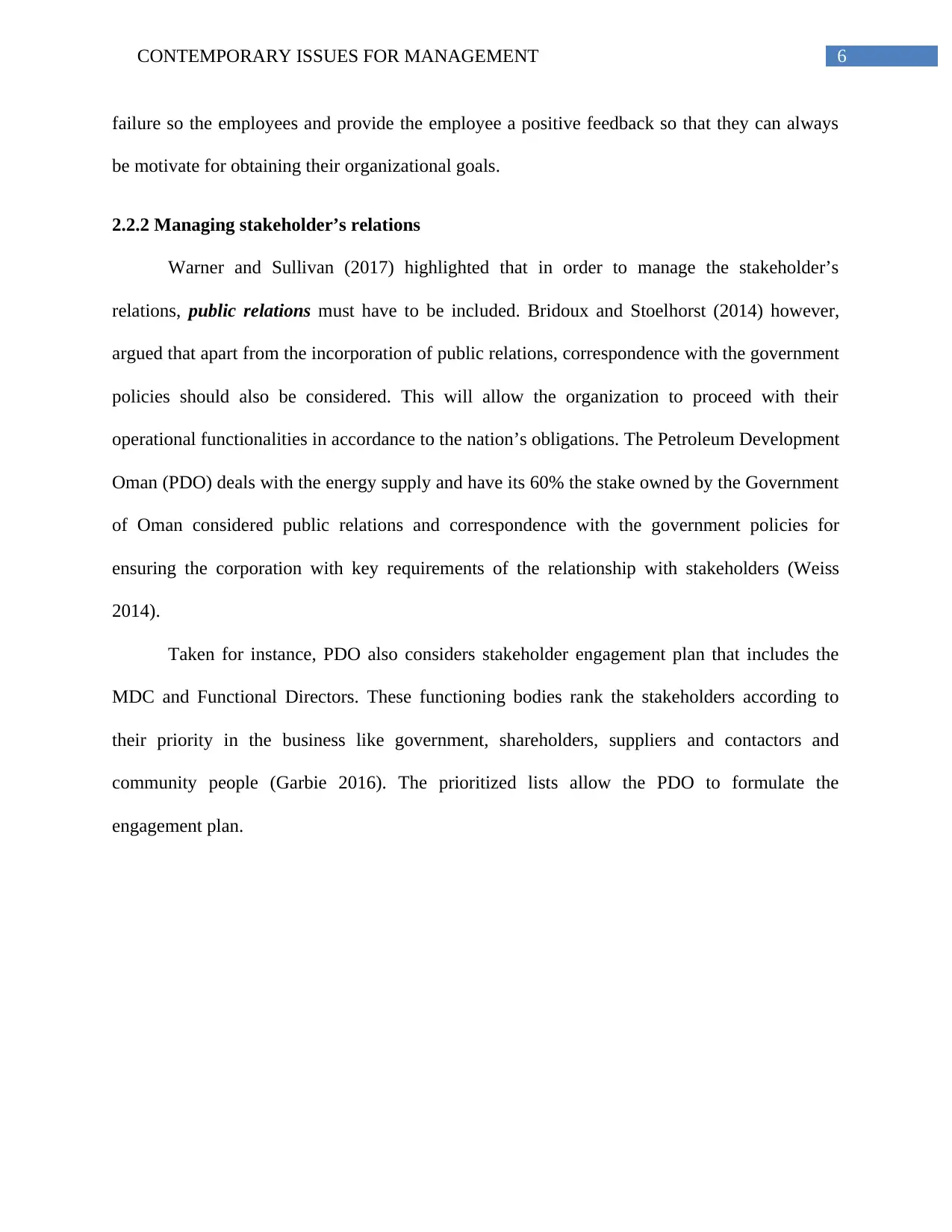
6CONTEMPORARY ISSUES FOR MANAGEMENT
failure so the employees and provide the employee a positive feedback so that they can always
be motivate for obtaining their organizational goals.
2.2.2 Managing stakeholder’s relations
Warner and Sullivan (2017) highlighted that in order to manage the stakeholder’s
relations, public relations must have to be included. Bridoux and Stoelhorst (2014) however,
argued that apart from the incorporation of public relations, correspondence with the government
policies should also be considered. This will allow the organization to proceed with their
operational functionalities in accordance to the nation’s obligations. The Petroleum Development
Oman (PDO) deals with the energy supply and have its 60% the stake owned by the Government
of Oman considered public relations and correspondence with the government policies for
ensuring the corporation with key requirements of the relationship with stakeholders (Weiss
2014).
Taken for instance, PDO also considers stakeholder engagement plan that includes the
MDC and Functional Directors. These functioning bodies rank the stakeholders according to
their priority in the business like government, shareholders, suppliers and contactors and
community people (Garbie 2016). The prioritized lists allow the PDO to formulate the
engagement plan.
failure so the employees and provide the employee a positive feedback so that they can always
be motivate for obtaining their organizational goals.
2.2.2 Managing stakeholder’s relations
Warner and Sullivan (2017) highlighted that in order to manage the stakeholder’s
relations, public relations must have to be included. Bridoux and Stoelhorst (2014) however,
argued that apart from the incorporation of public relations, correspondence with the government
policies should also be considered. This will allow the organization to proceed with their
operational functionalities in accordance to the nation’s obligations. The Petroleum Development
Oman (PDO) deals with the energy supply and have its 60% the stake owned by the Government
of Oman considered public relations and correspondence with the government policies for
ensuring the corporation with key requirements of the relationship with stakeholders (Weiss
2014).
Taken for instance, PDO also considers stakeholder engagement plan that includes the
MDC and Functional Directors. These functioning bodies rank the stakeholders according to
their priority in the business like government, shareholders, suppliers and contactors and
community people (Garbie 2016). The prioritized lists allow the PDO to formulate the
engagement plan.
Paraphrase This Document
Need a fresh take? Get an instant paraphrase of this document with our AI Paraphraser
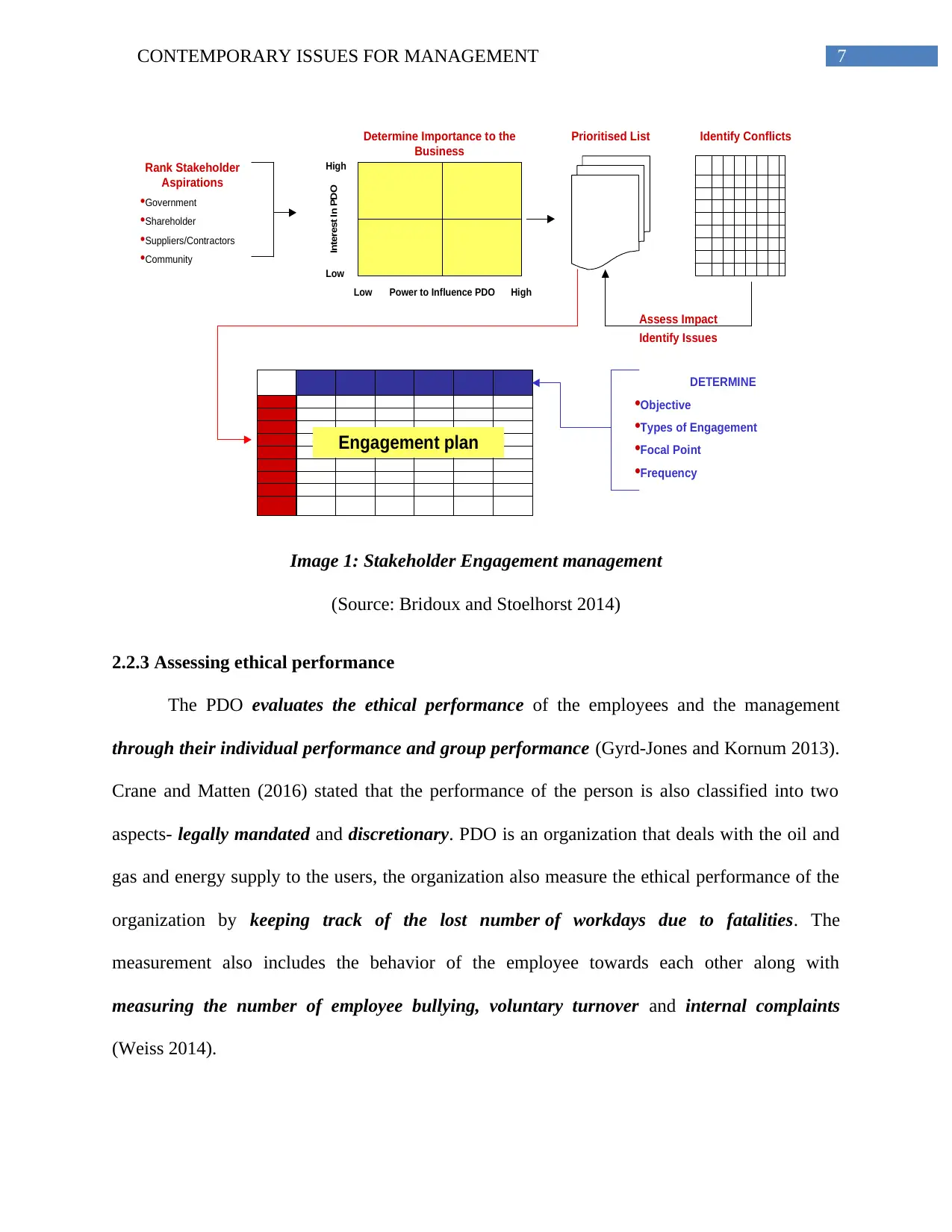
7CONTEMPORARY ISSUES FOR MANAGEMENT
Rank Stakeholder
Aspirations
• Government
• Shareholder
• Suppliers/Contractors
• Community
Low High
Low
High
Interest In PDO
Power to Influence PDO
Determine Importance to the
Business
Prioritised List Identify Conflicts
Assess Impact
Identify Issues
Engagement plan
DETERMINE
•Objective
•Types of Engagement
•Focal Point
•Frequency
Image 1: Stakeholder Engagement management
(Source: Bridoux and Stoelhorst 2014)
2.2.3 Assessing ethical performance
The PDO evaluates the ethical performance of the employees and the management
through their individual performance and group performance (Gyrd-Jones and Kornum 2013).
Crane and Matten (2016) stated that the performance of the person is also classified into two
aspects- legally mandated and discretionary. PDO is an organization that deals with the oil and
gas and energy supply to the users, the organization also measure the ethical performance of the
organization by keeping track of the lost number of workdays due to fatalities. The
measurement also includes the behavior of the employee towards each other along with
measuring the number of employee bullying, voluntary turnover and internal complaints
(Weiss 2014).
Rank Stakeholder
Aspirations
• Government
• Shareholder
• Suppliers/Contractors
• Community
Low High
Low
High
Interest In PDO
Power to Influence PDO
Determine Importance to the
Business
Prioritised List Identify Conflicts
Assess Impact
Identify Issues
Engagement plan
DETERMINE
•Objective
•Types of Engagement
•Focal Point
•Frequency
Image 1: Stakeholder Engagement management
(Source: Bridoux and Stoelhorst 2014)
2.2.3 Assessing ethical performance
The PDO evaluates the ethical performance of the employees and the management
through their individual performance and group performance (Gyrd-Jones and Kornum 2013).
Crane and Matten (2016) stated that the performance of the person is also classified into two
aspects- legally mandated and discretionary. PDO is an organization that deals with the oil and
gas and energy supply to the users, the organization also measure the ethical performance of the
organization by keeping track of the lost number of workdays due to fatalities. The
measurement also includes the behavior of the employee towards each other along with
measuring the number of employee bullying, voluntary turnover and internal complaints
(Weiss 2014).
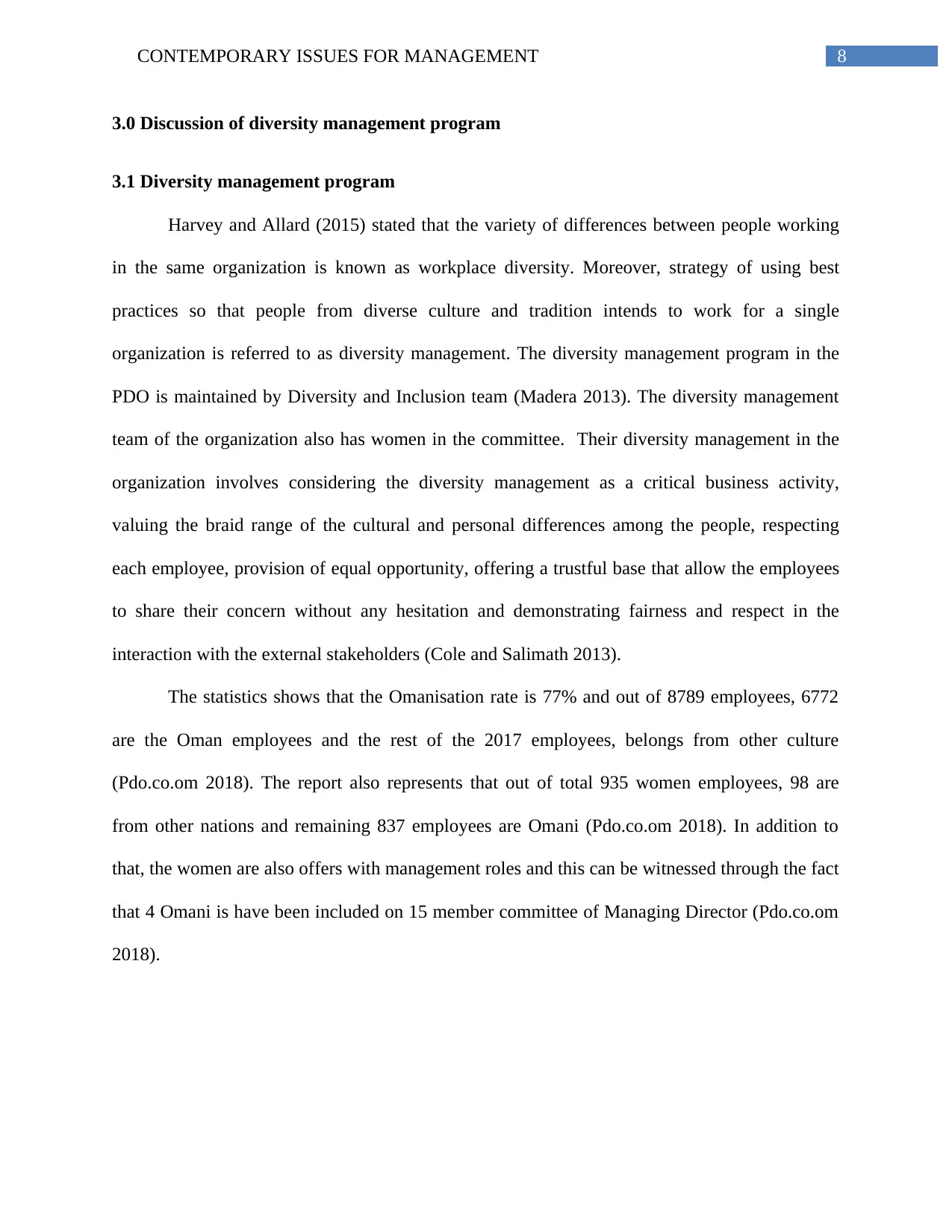
8CONTEMPORARY ISSUES FOR MANAGEMENT
3.0 Discussion of diversity management program
3.1 Diversity management program
Harvey and Allard (2015) stated that the variety of differences between people working
in the same organization is known as workplace diversity. Moreover, strategy of using best
practices so that people from diverse culture and tradition intends to work for a single
organization is referred to as diversity management. The diversity management program in the
PDO is maintained by Diversity and Inclusion team (Madera 2013). The diversity management
team of the organization also has women in the committee. Their diversity management in the
organization involves considering the diversity management as a critical business activity,
valuing the braid range of the cultural and personal differences among the people, respecting
each employee, provision of equal opportunity, offering a trustful base that allow the employees
to share their concern without any hesitation and demonstrating fairness and respect in the
interaction with the external stakeholders (Cole and Salimath 2013).
The statistics shows that the Omanisation rate is 77% and out of 8789 employees, 6772
are the Oman employees and the rest of the 2017 employees, belongs from other culture
(Pdo.co.om 2018). The report also represents that out of total 935 women employees, 98 are
from other nations and remaining 837 employees are Omani (Pdo.co.om 2018). In addition to
that, the women are also offers with management roles and this can be witnessed through the fact
that 4 Omani is have been included on 15 member committee of Managing Director (Pdo.co.om
2018).
3.0 Discussion of diversity management program
3.1 Diversity management program
Harvey and Allard (2015) stated that the variety of differences between people working
in the same organization is known as workplace diversity. Moreover, strategy of using best
practices so that people from diverse culture and tradition intends to work for a single
organization is referred to as diversity management. The diversity management program in the
PDO is maintained by Diversity and Inclusion team (Madera 2013). The diversity management
team of the organization also has women in the committee. Their diversity management in the
organization involves considering the diversity management as a critical business activity,
valuing the braid range of the cultural and personal differences among the people, respecting
each employee, provision of equal opportunity, offering a trustful base that allow the employees
to share their concern without any hesitation and demonstrating fairness and respect in the
interaction with the external stakeholders (Cole and Salimath 2013).
The statistics shows that the Omanisation rate is 77% and out of 8789 employees, 6772
are the Oman employees and the rest of the 2017 employees, belongs from other culture
(Pdo.co.om 2018). The report also represents that out of total 935 women employees, 98 are
from other nations and remaining 837 employees are Omani (Pdo.co.om 2018). In addition to
that, the women are also offers with management roles and this can be witnessed through the fact
that 4 Omani is have been included on 15 member committee of Managing Director (Pdo.co.om
2018).
⊘ This is a preview!⊘
Do you want full access?
Subscribe today to unlock all pages.

Trusted by 1+ million students worldwide
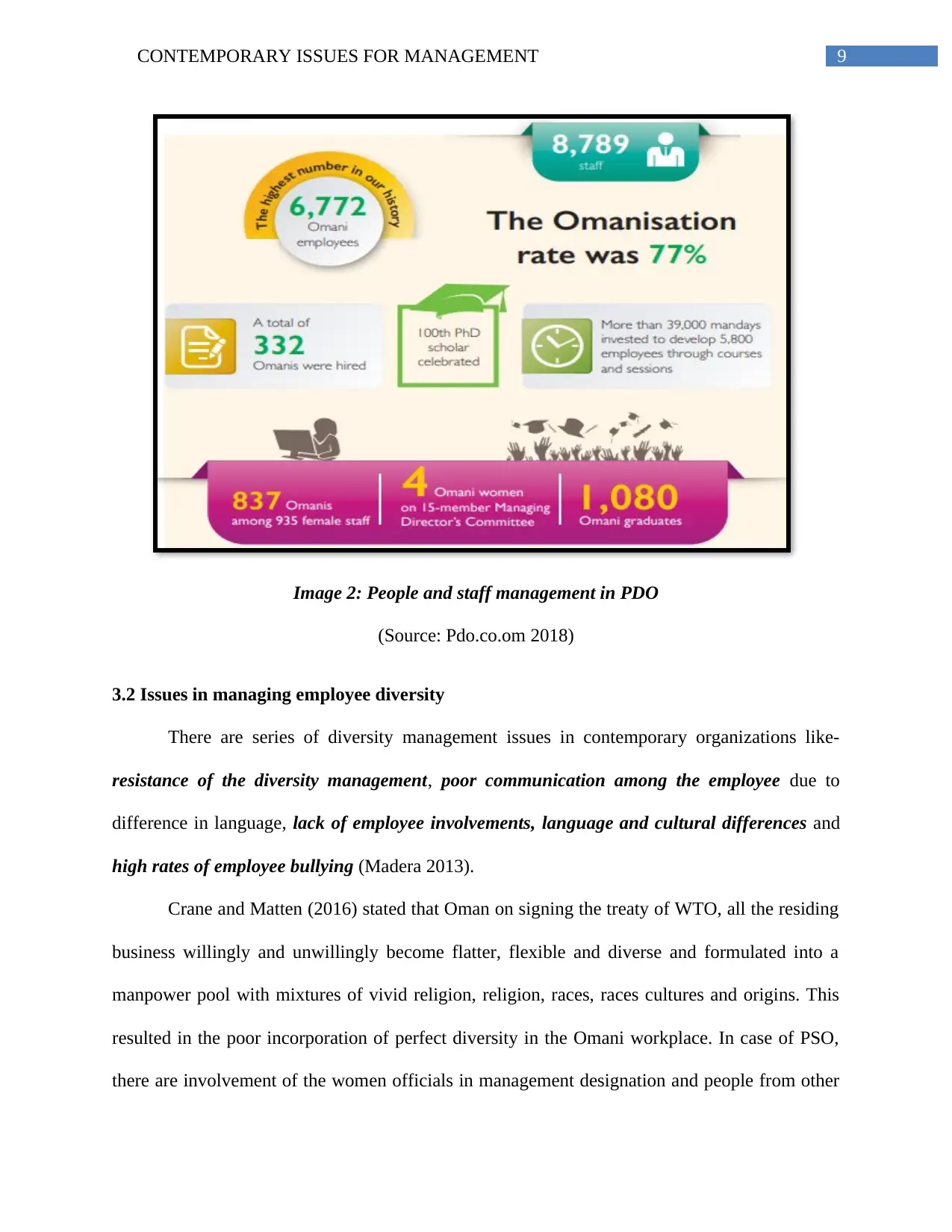
9CONTEMPORARY ISSUES FOR MANAGEMENT
Image 2: People and staff management in PDO
(Source: Pdo.co.om 2018)
3.2 Issues in managing employee diversity
There are series of diversity management issues in contemporary organizations like-
resistance of the diversity management, poor communication among the employee due to
difference in language, lack of employee involvements, language and cultural differences and
high rates of employee bullying (Madera 2013).
Crane and Matten (2016) stated that Oman on signing the treaty of WTO, all the residing
business willingly and unwillingly become flatter, flexible and diverse and formulated into a
manpower pool with mixtures of vivid religion, religion, races, races cultures and origins. This
resulted in the poor incorporation of perfect diversity in the Omani workplace. In case of PSO,
there are involvement of the women officials in management designation and people from other
Image 2: People and staff management in PDO
(Source: Pdo.co.om 2018)
3.2 Issues in managing employee diversity
There are series of diversity management issues in contemporary organizations like-
resistance of the diversity management, poor communication among the employee due to
difference in language, lack of employee involvements, language and cultural differences and
high rates of employee bullying (Madera 2013).
Crane and Matten (2016) stated that Oman on signing the treaty of WTO, all the residing
business willingly and unwillingly become flatter, flexible and diverse and formulated into a
manpower pool with mixtures of vivid religion, religion, races, races cultures and origins. This
resulted in the poor incorporation of perfect diversity in the Omani workplace. In case of PSO,
there are involvement of the women officials in management designation and people from other
Paraphrase This Document
Need a fresh take? Get an instant paraphrase of this document with our AI Paraphraser
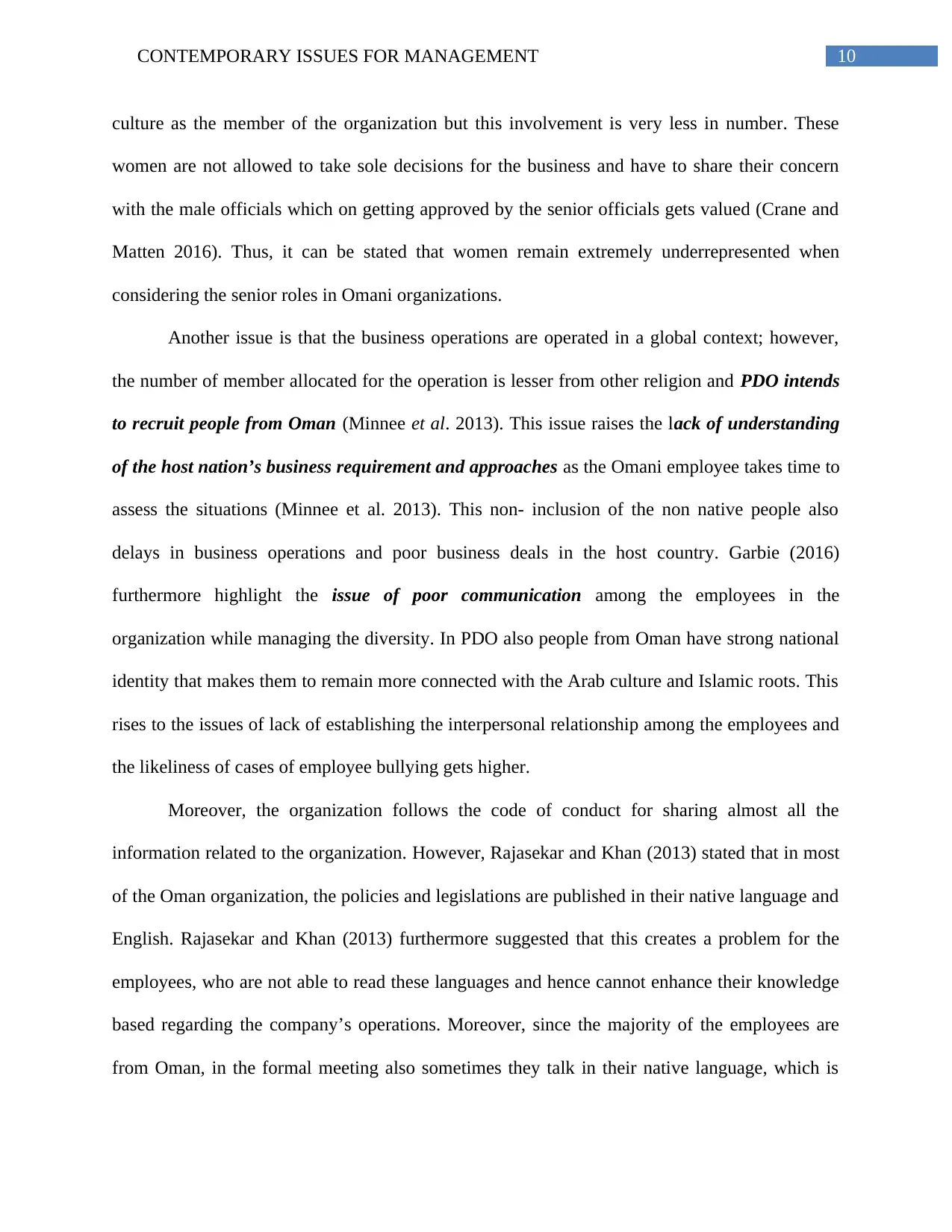
10CONTEMPORARY ISSUES FOR MANAGEMENT
culture as the member of the organization but this involvement is very less in number. These
women are not allowed to take sole decisions for the business and have to share their concern
with the male officials which on getting approved by the senior officials gets valued (Crane and
Matten 2016). Thus, it can be stated that women remain extremely underrepresented when
considering the senior roles in Omani organizations.
Another issue is that the business operations are operated in a global context; however,
the number of member allocated for the operation is lesser from other religion and PDO intends
to recruit people from Oman (Minnee et al. 2013). This issue raises the lack of understanding
of the host nation’s business requirement and approaches as the Omani employee takes time to
assess the situations (Minnee et al. 2013). This non- inclusion of the non native people also
delays in business operations and poor business deals in the host country. Garbie (2016)
furthermore highlight the issue of poor communication among the employees in the
organization while managing the diversity. In PDO also people from Oman have strong national
identity that makes them to remain more connected with the Arab culture and Islamic roots. This
rises to the issues of lack of establishing the interpersonal relationship among the employees and
the likeliness of cases of employee bullying gets higher.
Moreover, the organization follows the code of conduct for sharing almost all the
information related to the organization. However, Rajasekar and Khan (2013) stated that in most
of the Oman organization, the policies and legislations are published in their native language and
English. Rajasekar and Khan (2013) furthermore suggested that this creates a problem for the
employees, who are not able to read these languages and hence cannot enhance their knowledge
based regarding the company’s operations. Moreover, since the majority of the employees are
from Oman, in the formal meeting also sometimes they talk in their native language, which is
culture as the member of the organization but this involvement is very less in number. These
women are not allowed to take sole decisions for the business and have to share their concern
with the male officials which on getting approved by the senior officials gets valued (Crane and
Matten 2016). Thus, it can be stated that women remain extremely underrepresented when
considering the senior roles in Omani organizations.
Another issue is that the business operations are operated in a global context; however,
the number of member allocated for the operation is lesser from other religion and PDO intends
to recruit people from Oman (Minnee et al. 2013). This issue raises the lack of understanding
of the host nation’s business requirement and approaches as the Omani employee takes time to
assess the situations (Minnee et al. 2013). This non- inclusion of the non native people also
delays in business operations and poor business deals in the host country. Garbie (2016)
furthermore highlight the issue of poor communication among the employees in the
organization while managing the diversity. In PDO also people from Oman have strong national
identity that makes them to remain more connected with the Arab culture and Islamic roots. This
rises to the issues of lack of establishing the interpersonal relationship among the employees and
the likeliness of cases of employee bullying gets higher.
Moreover, the organization follows the code of conduct for sharing almost all the
information related to the organization. However, Rajasekar and Khan (2013) stated that in most
of the Oman organization, the policies and legislations are published in their native language and
English. Rajasekar and Khan (2013) furthermore suggested that this creates a problem for the
employees, who are not able to read these languages and hence cannot enhance their knowledge
based regarding the company’s operations. Moreover, since the majority of the employees are
from Oman, in the formal meeting also sometimes they talk in their native language, which is
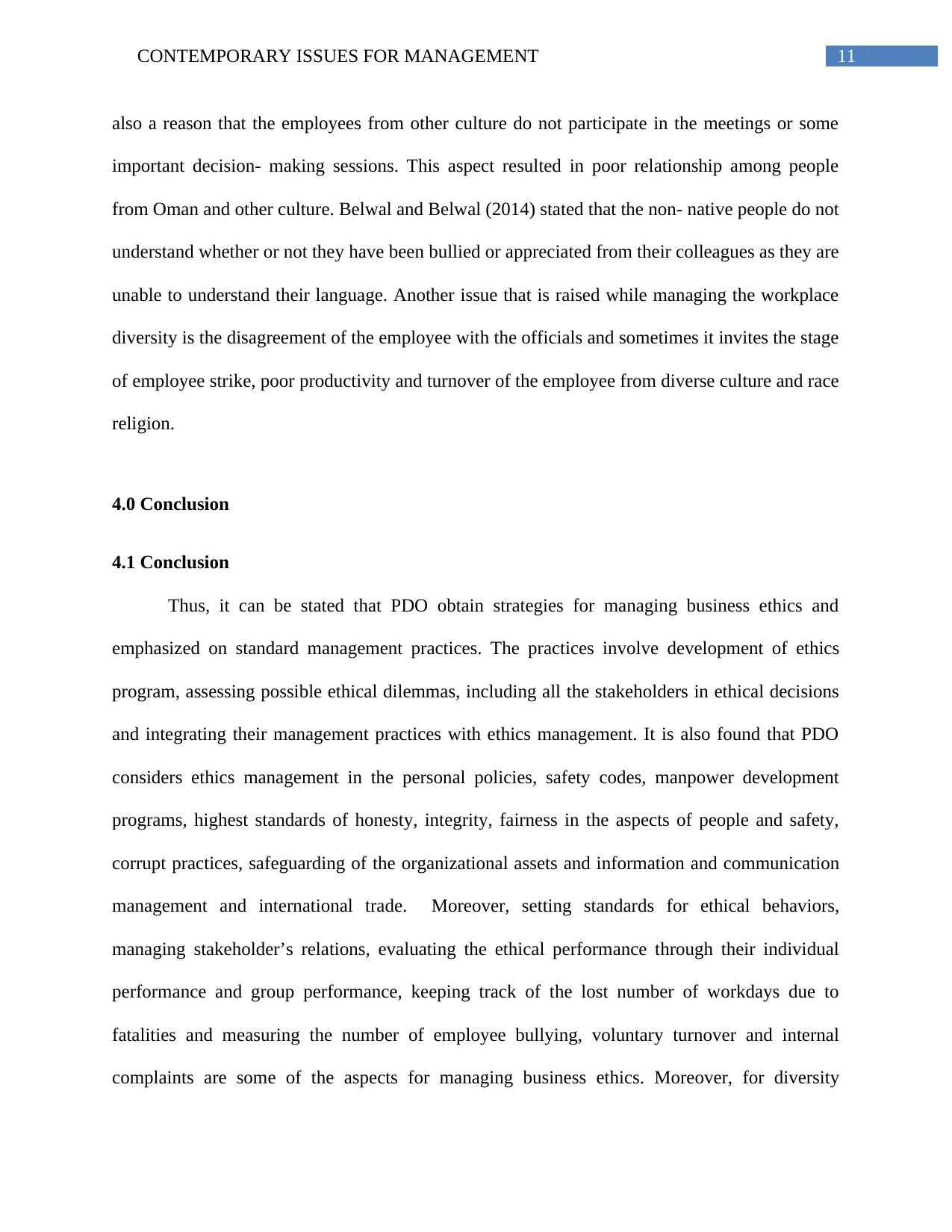
11CONTEMPORARY ISSUES FOR MANAGEMENT
also a reason that the employees from other culture do not participate in the meetings or some
important decision- making sessions. This aspect resulted in poor relationship among people
from Oman and other culture. Belwal and Belwal (2014) stated that the non- native people do not
understand whether or not they have been bullied or appreciated from their colleagues as they are
unable to understand their language. Another issue that is raised while managing the workplace
diversity is the disagreement of the employee with the officials and sometimes it invites the stage
of employee strike, poor productivity and turnover of the employee from diverse culture and race
religion.
4.0 Conclusion
4.1 Conclusion
Thus, it can be stated that PDO obtain strategies for managing business ethics and
emphasized on standard management practices. The practices involve development of ethics
program, assessing possible ethical dilemmas, including all the stakeholders in ethical decisions
and integrating their management practices with ethics management. It is also found that PDO
considers ethics management in the personal policies, safety codes, manpower development
programs, highest standards of honesty, integrity, fairness in the aspects of people and safety,
corrupt practices, safeguarding of the organizational assets and information and communication
management and international trade. Moreover, setting standards for ethical behaviors,
managing stakeholder’s relations, evaluating the ethical performance through their individual
performance and group performance, keeping track of the lost number of workdays due to
fatalities and measuring the number of employee bullying, voluntary turnover and internal
complaints are some of the aspects for managing business ethics. Moreover, for diversity
also a reason that the employees from other culture do not participate in the meetings or some
important decision- making sessions. This aspect resulted in poor relationship among people
from Oman and other culture. Belwal and Belwal (2014) stated that the non- native people do not
understand whether or not they have been bullied or appreciated from their colleagues as they are
unable to understand their language. Another issue that is raised while managing the workplace
diversity is the disagreement of the employee with the officials and sometimes it invites the stage
of employee strike, poor productivity and turnover of the employee from diverse culture and race
religion.
4.0 Conclusion
4.1 Conclusion
Thus, it can be stated that PDO obtain strategies for managing business ethics and
emphasized on standard management practices. The practices involve development of ethics
program, assessing possible ethical dilemmas, including all the stakeholders in ethical decisions
and integrating their management practices with ethics management. It is also found that PDO
considers ethics management in the personal policies, safety codes, manpower development
programs, highest standards of honesty, integrity, fairness in the aspects of people and safety,
corrupt practices, safeguarding of the organizational assets and information and communication
management and international trade. Moreover, setting standards for ethical behaviors,
managing stakeholder’s relations, evaluating the ethical performance through their individual
performance and group performance, keeping track of the lost number of workdays due to
fatalities and measuring the number of employee bullying, voluntary turnover and internal
complaints are some of the aspects for managing business ethics. Moreover, for diversity
⊘ This is a preview!⊘
Do you want full access?
Subscribe today to unlock all pages.

Trusted by 1+ million students worldwide
1 out of 16
Related Documents
Your All-in-One AI-Powered Toolkit for Academic Success.
+13062052269
info@desklib.com
Available 24*7 on WhatsApp / Email
![[object Object]](/_next/static/media/star-bottom.7253800d.svg)
Unlock your academic potential
Copyright © 2020–2025 A2Z Services. All Rights Reserved. Developed and managed by ZUCOL.





